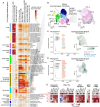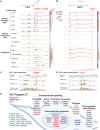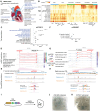This is a preprint.
Molecular convergence of risk variants for congenital heart defects leveraging a regulatory map of the human fetal heart
- PMID: 39606363
- PMCID: PMC11601760
- DOI: 10.1101/2024.11.20.24317557
Molecular convergence of risk variants for congenital heart defects leveraging a regulatory map of the human fetal heart
Abstract
Congenital heart defects (CHD) arise in part due to inherited genetic variants that alter genes and noncoding regulatory elements in the human genome. These variants are thought to act during fetal development to influence the formation of different heart structures. However, identifying the genes, pathways, and cell types that mediate these effects has been challenging due to the immense diversity of cell types involved in heart development as well as the superimposed complexities of interpreting noncoding sequences. As such, understanding the molecular functions of both noncoding and coding variants remains paramount to our fundamental understanding of cardiac development and CHD. Here, we created a gene regulation map of the healthy human fetal heart across developmental time, and applied it to interpret the functions of variants associated with CHD and quantitative cardiac traits. We collected single-cell multiomic data from 734,000 single cells sampled from 41 fetal hearts spanning post-conception weeks 6 to 22, enabling the construction of gene regulation maps in 90 cardiac cell types and states, including rare populations of cardiac conduction cells. Through an unbiased analysis of all 90 cell types, we find that both rare coding variants associated with CHD and common noncoding variants associated with valve traits converge to affect valvular interstitial cells (VICs). VICs are enriched for high expression of known CHD genes previously identified through mapping of rare coding variants. Eight CHD genes, as well as other genes in similar molecular pathways, are linked to common noncoding variants associated with other valve diseases or traits via enhancers in VICs. In addition, certain common noncoding variants impact enhancers with activities highly specific to particular subanatomic structures in the heart, illuminating how such variants can impact specific aspects of heart structure and function. Together, these results implicate new enhancers, genes, and cell types in the genetic etiology of CHD, identify molecular convergence of common noncoding and rare coding variants on VICs, and suggest a more expansive view of the cell types instrumental in genetic risk for CHD, beyond the working cardiomyocyte. This regulatory map of the human fetal heart will provide a foundational resource for understanding cardiac development, interpreting genetic variants associated with heart disease, and discovering targets for cell-type specific therapies.
Conflict of interest statement
Conflict of Interest Statement J.M.E. has received materials from 10x Genomics unrelated to this study.
Figures





References
Publication types
Grants and funding
- R01 HL158525/HL/NHLBI NIH HHS/United States
- R01 DE028599/DE/NIDCR NIH HHS/United States
- R01 HL151535/HL/NHLBI NIH HHS/United States
- T32 GM087237/GM/NIGMS NIH HHS/United States
- UM1 HG011972/HG/NHGRI NIH HHS/United States
- R01 HL159176/HL/NHLBI NIH HHS/United States
- U01 HG012069/HG/NHGRI NIH HHS/United States
- R01 HL156846/HL/NHLBI NIH HHS/United States
- R01 HG003988/HG/NHGRI NIH HHS/United States
- K08 HL159346/HL/NHLBI NIH HHS/United States
- R01 HL171045/HL/NHLBI NIH HHS/United States
- R01 HL166283/HL/NHLBI NIH HHS/United States
- K08 HL157700/HL/NHLBI NIH HHS/United States
- R01 HD114353/HD/NICHD NIH HHS/United States
- R01 HL162304/HL/NHLBI NIH HHS/United States
- R01 HL152134/HL/NHLBI NIH HHS/United States
- R01 HL139478/HL/NHLBI NIH HHS/United States
- R00 HG012887/HG/NHGRI NIH HHS/United States
- R24 HD000836/HD/NICHD NIH HHS/United States
- DP2 HG014282/HG/NHGRI NIH HHS/United States
- T32 HG000044/HG/NHGRI NIH HHS/United States
- R01 HL134817/HL/NHLBI NIH HHS/United States
- R35 GM141861/GM/NIGMS NIH HHS/United States
- K22 HG000044/HG/NHGRI NIH HHS/United States
LinkOut - more resources
Full Text Sources
Research Materials
